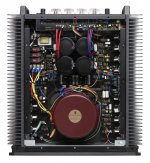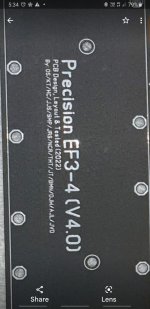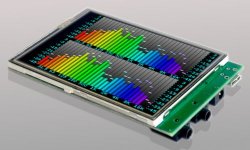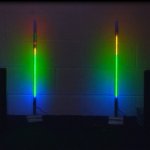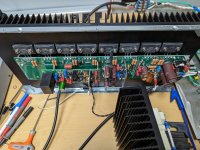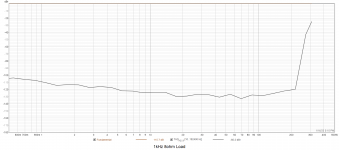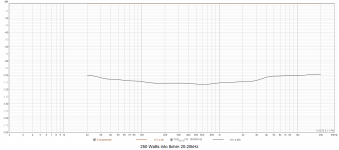Is anything wrong with .6-watt ones? I have built it in line with the guidance and it says 0.6.
The only regret is not building with vishay as it is much easier to read numbers than stripes.
Hi @ostripper , thanks for taking the time to study the wolverine project a little deeper. I see you have posed some questions. We'll take a look and get back to you. I just wanted to say this has been a massive team effort by all members of the wolverine team. When have spent I would estimate well over 2500 man hours on this. All the members are noted on the PCB's including yourself.Been a while ....
I do see this amp performs as planned - actually better.
- I'm just curious how the pre-drivers are now heatsinked. It does not hurt ??
- The wolverine CCS has become an "overkill" TO-126 "beast". I guess this wont hurt , lower pF with those to-126's.
- strange addition of diodes in the cap multiplier/regulator section.
- and , the option of having the vbe closer to the outputs.
I suppose these are minor esoteric design choices ... as the resulting performance beats just about anything on the planet. Most 20K$ audiophile amps are 20-30ppm. I could beat this with a class A output stage instead of a an EF3. In fact , my next project is a Badger class A headphone amp with Jung
super-regulators and digital (Arduino) control.
Nice job , Stuart - Cheers !!
Are those tests right .... sub PPM - yikes ??
Attachments
Yep, those low distortion measurements are correct. Boards were tested in Australia, Canada, Greece and the USA.
Oh , don't worry. stuart. This baby is all yours. I'm pretty much split between A/B subs and class D satellites. I don't have room (or $) for monster amps.
I will design DAC's and headphone amps with discrete. My "monster amp" days are over. I'm glad all your builders are having fun with such audiophile results.
The Wolverine is my "middle finger" to some of the higher level designers on this forum. I mean this in a good way ,as it disproves some "pitchfork villager"
condescending attitudes many years ago.
BTW , I just read this whole thread ... there are those who doubt. Be nice !!
I will design DAC's and headphone amps with discrete. My "monster amp" days are over. I'm glad all your builders are having fun with such audiophile results.
The Wolverine is my "middle finger" to some of the higher level designers on this forum. I mean this in a good way ,as it disproves some "pitchfork villager"
condescending attitudes many years ago.
BTW , I just read this whole thread ... there are those who doubt. Be nice !!
We changed R17 to 1 watt in the latest BOM (s). Andy reported that the 0.5W resistor was getting warm, in that position.Is anything wrong with .6-watt ones? I have built it in line with the guidance and it says 0.6.
The only regret is not building with vishay as it is much easier to read numbers than stripes.
😍In fact , my next project is a Badger class A headphone amp with Jung
super-regulators and digital (Arduino) control.
Maybe I'll design (and code) some real accurate Arduino power meters for these beautiful Wolverines. I even know enough now to monitor VI to
semi mute and protect the amp. My power meter on the wall will flash the RGB's like a strobe if it see's too many "clips". ADC's are my friend.
Got good DAC's too , my ASUS U7 mk2 would sing on a wolverine. But I don't have the space. My subs are "Badgers'. I would not waste a Wolverine on a sub
..... "blasphemy" he he.
semi mute and protect the amp. My power meter on the wall will flash the RGB's like a strobe if it see's too many "clips". ADC's are my friend.
Got good DAC's too , my ASUS U7 mk2 would sing on a wolverine. But I don't have the space. My subs are "Badgers'. I would not waste a Wolverine on a sub
..... "blasphemy" he he.
You could do full color OLED (spectrum) or full RGB bargraph VU/power with a single AT328 7$ CPU and W2812b led's.
Photo 2 is what is on my wall - .01 to 60W or -70db to +6db. I could scale it to any amp/input. Along with the metering , any power level
could become a digital output to mute the amp (or reset it). ESP32 wifi , one can even adjust amp bias and volume with a phone. yeah !!
Photo 2 is what is on my wall - .01 to 60W or -70db to +6db. I could scale it to any amp/input. Along with the metering , any power level
could become a digital output to mute the amp (or reset it). ESP32 wifi , one can even adjust amp bias and volume with a phone. yeah !!
Attachments
I'll offer it once , since I like how this has turned out .... I can design a few more input stages to allow the use of this modular design.
(Spooky , CFA , hawkford cascodes). I doubt they could match the PPM performance of the wolverine , but might present different
"character" with the wolverine's EF3 OPS.
Oh , BTW ... the lowly 7$ 328 CPU can even display a full oscilloscope on a OLED along with peak readings ,clip detection. One oscilloscope per channel
for <30$.
(Spooky , CFA , hawkford cascodes). I doubt they could match the PPM performance of the wolverine , but might present different
"character" with the wolverine's EF3 OPS.
Oh , BTW ... the lowly 7$ 328 CPU can even display a full oscilloscope on a OLED along with peak readings ,clip detection. One oscilloscope per channel
for <30$.
Last edited:
By the way, thanks to this forum, The W team and all preceding builds, I have a newfound interest in electronics, especially the IoT part of peripherals. I acquired some soldering and schematics reading skills, which is a bonus and looks like my dabbing with python will be handy with C if I decide to go the low-level low energy devices route.
This OLED(spectrum) would be an excellent choice for an amplifier.You could do full color OLED (spectrum) or full RGB bargraph VU/power with a single AT328 7$ CPU and W2812b led's.
Photo 2 is what is on my wall - .01 to 60W or -70db to +6db. I could scale it to any amp/input. Along with the metering , any power level
could become a digital output to mute the amp (or reset it). ESP32 wifi , one can even adjust amp bias and volume with a phone. yeah !!
Please post here when you are ready!

An ESP32 compatible volume controller need a special chip(like PGA2311) to work or you have a different solution?
Last edited:
Btw I would not mind learning how to implement oled spectrum myself, at least what lies behind it. Any tips where to begin?
muses72323 looks very promising on paper. I am currently building a pre-amp with it. I have not used it before, but the reviews seem promising. Also used in pretty expensive Burson Audio products.This OLED(spectrum) would be an excellent choice for an amplifier.
Please post here when you are ready!
An ESP32 compatible volume controller need a special chip(like PGA2311) to work or you have a different solution?
https://projecthub.arduino.cc/shajeeb/924af5cb-be01-44d6-888d-200c54188e9b
That is the basic led matrix using the FFT of a atmega ADC.
You just need the library of whatever display you use. the led matrix is just a simple ( #include <MD_MAX72xx.h>)
Other display's need their own precompiled library. My VU's use the #arduinoFFT library with all samples combined.
I use lm324's with protection diodes as a buffer for my ADC's . No way to burn anything out. scaling and freq. is all set
in the coding. All 5V AC coupled as well , no extra power supplies.
That is the basic led matrix using the FFT of a atmega ADC.
You just need the library of whatever display you use. the led matrix is just a simple ( #include <MD_MAX72xx.h>)
Other display's need their own precompiled library. My VU's use the #arduinoFFT library with all samples combined.
I use lm324's with protection diodes as a buffer for my ADC's . No way to burn anything out. scaling and freq. is all set
in the coding. All 5V AC coupled as well , no extra power supplies.
Ps - we might be going off topic. Might want to go to the wolverine design thread for these "accessories'.
SMPS's as well. If we do as good as we did on the amp , the accessories will be perfection , as well.
SMPS's as well. If we do as good as we did on the amp , the accessories will be perfection , as well.
We are pretty close to those numbers, here is an EF3-4 with Sanken outputs that I am working on. Note the distortion vs. frequency taken at 250 watts 8 ohmWith these specs , someone with a wolverine should put it up against a 3K$ Parasound A21+ The parasound has more current and faster slew , but the wolverine has it "whupped" in PPM. Nice dominant 2nd harmonic , as well. World class !
Slew rate 129V/us 😎
Attachments
The final ips template is attached to the first post of this thread for anyone who would like to create there own ips.I'll offer it once , since I like how this has turned out .... I can design a few more input stages to allow the use of this modular design.
(Spooky , CFA , hawkford cascodes). I doubt they could match the PPM performance of the wolverine , but might present different
"character" with the wolverine's EF3 OPS.
Oh , BTW ... the lowly 7$ 328 CPU can even display a full oscilloscope on a OLED along with peak readings ,clip detection. One oscilloscope per channel
for <30$.
It's also possible to have a slightly longer one for the EF3-4 boards.
I'll upload that tomorrow sometime.
Beaten ! Just think someone was "dissing" sanken devices on the build thread. I like those MT-200's , my favorite output pair is 2sa1295 /2sc3264.We are pretty close to those numbers, here is an EF3-4 with Sanken outputs that I am working on. Note the distortion vs. frequency taken at 250 watts 8 ohm
Slew rate 129V/us 😎
The small sanken's are "fast" high gain/Ft. I remember shorting amps out just to see if I could blow those devices.
Oh wow , 4 pair of my favorite's .... that is one powerful amp. PPM at 250W - wow !!
- Home
- Amplifiers
- Solid State
- DIY Class A/B Amp The "Wolverine" build thread
